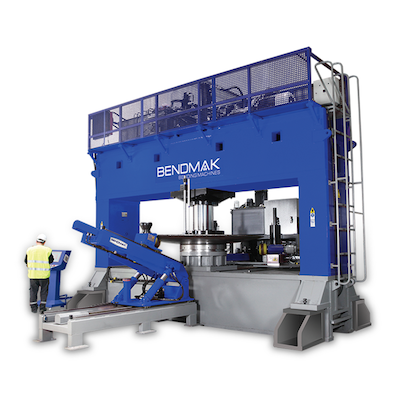
Posted By: Talip Tuzlular | Posted On: Jun 17, 2022 12:00:00 AM
How to Roll Out Flats When Plate Rolling on a 4-Roll Machine
It would be fair to say that plate rolling is an art in comparison to many other processes in the fabrication world. Being a skilled and seasoned plate rolling machine operator is as important as having the proper machinery and equipment in order to achieve the desired job results. In order to help out operators to improve their skills in the art of rolling, we will briefly shed a light on the concept of plate rolling and elaborate specifically on the matter of rolling out flats when plate rolling on a 4-roll machine.
What is Plate Rolling?
In a nutshell, plate rolling refers to the process in which sheet metals (plates) and the rolls of a plate rolling machine move simultaneously and give the materials various forms. Having a 4-roll plate roll definitely makes the plate rolling process much simpler. In addition to that, the proper setup, right equipment and features such as CNC controller, side and vertical supports etc. are very important for efficiency and safety reasons.
What is Flat Rolling?
Flat rolling process takes place between the top and bottom rolls of a plate rolling machine. The material fed through the rolls will typically have greater thickness as opposed to the distance between the bottom tangent point of a top roll and the top tangent point of a bottom roll. This causes the material to deform and elongate while the flat formation of the material remains the same.
Why Do 4-Roll Machines Require Special Considerations When Rolling Out Flats?
Even though flat rolling is considered the most basic type of rolling, it is still important to choose the right machine for it. Today most 4-roll plate rolling machines come with a variety of technical capabilities and thanks to having 4 rolls, it makes it much easier to manipulate, roll and measure the results on materials.
Very heavy and thick plates are typically formed with a press. This process is called “forging”. For thinner materials, flat rolling is a very popular method among the fabrication world and 4 roll plate rolls provide highly efficient and effective flat rolling solutions. Check out the following video to see what Bendmak 4 roll plate rolling machines can do: https://www.youtube.com/watch?v=qA9B_8-Ho1M
How to Roll Out the Flats When Plate Rolling on a 4-Roll Machine
With the help of friction, two opposite-direction running rolls on material cause a decrease in the thickness of material. Also the friction makes the material push through the rolls. This process makes the material elongate and after the rolling, the sheets are supposed to be thinner compared to the thickness of the material before the flat rolling process had begun.
The workability of material can be increased by using heat on the rolls. There are also some other methods that can help roll the material, such as using lubrication to avoid material sticking to the rolls and having a speed adjustment function on your plate rolling machine.
Determine Which Type of Material You’re Rolling
Determining the type of material before beginning the flat rolling process is critical. Aluminum, steel, copper and the alloys derived from these materials are the ones you will typically find in most fabrications shops. Each of these materials will have different tensile strengths, yield points, grain structures and many other structural characteristics. All of these variables make a difference during a flat rolling process on a plate rolling machine and end results will vary. The softer the material gets, less pressure is required to press the material.
Take Into Account Material Thickness and Width
As we mentioned before, after the flat rolling process, the material will elongate. The material expansion shouldn’t exceed the maximum material width capacity of the plate rolling machine as the sheets would not have the room to expand towards. Typically the thicker and softer the material is, more elongation may be expected.
Verify the Yield Strength of the Plates
Yield strength refers to the level of stress a material can withstand before a permanent deformation occurs and the material can no longer form back to its original form. In flat rolling, the higher the yield strength of a material is, the more pressure a plate rolling machine needs to generate to elongate the material. Therefore, it is important to know the yield points of the materials one would need to roll in order to determine the most optimum plate rolling machine type selection.
Familiarize Yourself With the Machine’s Safety Devices
Always make sure that the plate rolling machine you have is equipped with safety devices. Most plate rolling machines come with standard safety switches & ropes, sensors and mechanical attachments to keep operators as safe as possible and protect them from any unpredictable machine or material motions. To be more specific to flat rolling, one of the most effective ways of safely controlling the material would be having side supports on the plate rolling machine.
Shop Bendmak Plate Roll Systems
Bendmak plate rolling machines are designed and equipped with the state of the art technology and have the capabilities to offer solutions to all your rolling needs. Here is the list of the different types of plate rolling machines BendmakUSA has to offer:
- CY4R-HHS Series - 4-Roll Plate Rolls
- CY3R-HHS Series – 3-Roll Plate Rolls
- BHV Series – Variable Geometry 3-Roll Plate Rolls
- CYL-ST Series – 3-Roll Initial Pinch Plate Rolls
- CYL Series – 3-Roll Initial Pinch Plate Rolls
- CY Series – 3 Roll Initial Pinch Plate Rolls
Check out our plate rolls on our website for more details or call us for more information at 833-BENDMAK (833-236-3625)



